-

人教版新目标初中英语七年级下册What do you think of game shows教案
五、教学Section B-2c1. Pair work: What do you think of the belt/sunglasses/…? What does your father/mother/… think of your scarf/belt…?2. Group work(1). Teacher shows some different kinds of school uniforms (制服)and asks : “ What do you think of your school uniforms? If you have a chance to choose your school uniforms, what kind would you like to choose?”(2). Discuss in groups.(3).Get some Ss to report in class.说明:这一步旨在让学生运用已有的语言知识谈论对事物的看法和意见,并简单阐明理由,培养学生的主动思维能力和运用英语的能力。六、教学拓展调查电视节目的收视率任务:调查你周围的人对现在各种电视节目的反响。活动过程:1.教师布置任务,让学生调查周围的人(包括他的亲戚朋友和邻居)喜欢收看哪方面的电视节目。2.学生进行调查活动,运用本单元所学的句型What do you think of….? (Why?)What's your favorite game shows?What do you think of talk show?I doesn’t mind it.I like it.I love it.I can’t stand it.3.记录下排在前10位的TV Program,填写调查表,比较其收视率。

人教版新目标初中英语七年级下册Where did you go on vacation教案
句型: Where did you go on vacation? I went to summer camp.Did she go to Central Park?Yes,she did.No, she didn’t语法:一般过去时特殊疑问句、一般疑问句及肯、否定回答。课时安排4课时第一课时:Section A:la,1b,lc,2a,2b,2c 第二课时:Section A:3a,3b,4第三课时:Section B:1,2a,2b,2c第四课时:Section B:3a,3b,3c,4 and Self Check第一课时教学目标掌握描写假期生活的形容词。假期里自己所做事情的简单表达。谈论假期做的事情及当时情况。谈论假期时旅游的天气,旅游者以及食物等。教学过程一、导入播放一首英文歌曲:Let’s travel 说明:通过让学生听节奏欢快迪斯尼英语歌曲Let’s travel.引入本节课谈论的话题vacation and travel. 让歌曲使学生的思维活跃,增强课堂气氛,激发学生提高学习英语的兴趣。T:How is the trip ?Ss : It’s pretty good/ happy/exciting /relaxing/busy/dangerous/ fantastic说明:这个问题是为了操练形容词。建议让多个Ss作答。鼓励他们用不同的形容词。上述个别形容词本应在第二课时中出现,但可以在warming-up中第一次非正式出现。这些形容词也可在老师的评价语中适时出现,以加深学生对词汇的印象。

人教版新目标初中英语八年级下册Have you ever been to an amusement park教案
(1)Have you ever been to …? Yes, I have. / Yes, I have ever been to …No, I haven’t. / No, I have never been to …(2)When did you go there? I went there last year. (3)I have never been to a water park. Neither have I. I have ever been to an amusement park. So have I. (4)How long have you been studying English? I’ve been studying English since nine o’clock. I’ve been studying English since I came back home. I’ve been studying English for five hours. (5)What’s that? It’s an amusement park in Japan. I’ve never been to an amusement park like it before. It’s fun to learn another language. Let’s go tonight. Isn’t this great?space museum, amusement park, water park, South America, Peru, Holland, European culture, tour guide, flight attendant, musical instrument, more than, be from, get to, take lessons, neither, discover, graduate, change

人教版新目标初中英语八年级下册Why don’t you get her a scarf教案
教师带领学生复习有关描述宠物的词汇,采用教师提问学生回答的方进行。如:T:What animals do you think would be good pets?What animals do you think would be bad pets?What do you think are good animals for a six-year-old child?然后学生进行 pairwork 练习。Task two: 师生互动,学习探究 1、播放3a部分的录音,引导学生一边听录音,一边跟读。2、通过听录音学生回答以下问题:Why do you think pot-bellied pigs are popular?What are the advantages and disadvantages of keeping such a pet?教师对学生的回答进行及时点评。3.学习范文,学习重点短语,为下步的模仿写作提供语言素材。T :1. )Have you ever kept a pig as a pet?Do you like pigs? St.:No.…Why don’t you like to keep a pig? St: No.They’re too dirty and lazy(Do you know in some foreign countries like Hollyland, Australia,pigs are the most popular pet.there’s a kind of pig.(图)it has an interesting name? it ‘s called a pot-bellied pig.) Now,let’s learn an article about this kind of interesting pet.2.)play the tapeSt.:Listen and repeat3.)show some Qs on computer(本子St.: read silently,then answerthe Qs(本子)4.)Ask ss. Close book and retell this passage.(what is a pot-bellied pig? Is it a good or bad pet? ) St.: retell it to each other“A pot –bellied pig is a popular pet now…”5.read the article together.St.:.practice reading

人教版新目标初中英语八年级下册Would you mind turning down the music教案
Step 4. Group work (4)1. Ask a pair of students to read the dialogue. Say, This activity provides speaking, listening and writing practice using the target language.2. Ask students to complete the work in groups.3. Check the answers with the whole class. 4. Explain some of the language points. Step 5. Word review (Self check 1)1. Ask students to read the words and the phrases given. 2. Fill in the blanks with proper forms of these words to complete the sentences. 3. Check the answers with the whole class. Homework:Do activity 2 on page 57 after class. Period 6Teaching aims: 1. Teach vocabulary words and the useful expressions. 2. Enable the students to learn etiquette in different culture. 3. Help the students learn how to behave politely in public places and in daily life. Teaching procedures:Step 1. RevisionHelp students to review the function of making requests through a free talk. Then lead them to the topic of etiquette. Explain the meaning of etiquette. Or, ask students to look it up in the dictionary. Step 2. Pre-reading (Section 1)1. Ask students to read the picture and make a list with their partner about how many rules of etiquette can be seen being broken.

人教版新目标初中英语九年级下册By the time I got outside, the bus had already left教案
Ⅰ. Teaching Aims and Demands1. Knowledge Objects(1) Key Vocabularyoversleep(2) Target LanguageWhat happened?I overslept. And by the time I got up, my brother had already gotten in the shower.2. Ability Objects(1) Teach the students to use the new words.(2) Train the students to narrate past events with the Past Perfect Tense.(3) Train the students' listening and speaking skills with the target language.3. Moral ObjectIt’s a good habit to go to bed early in the evening and get up early in the morning. So you’ll never be in a hurry in the morning.Ⅱ. Teaching Key Points1. Key Vocabularyoversleep2. Target LanguageNarrate past events with the Past Perfect TenseⅢ. Teaching Difficult Points1. Train the students to narrate past events with the Past Perfect Tense.2. Train the students to understand the target language in spoken conversation.Ⅳ. Teaching Methods1. Thinking of examples from the students' real lives.2. Making sentences by looking at the pictures.Ⅴ. Teaching AidA tape recorderⅥ. Teaching ProceduresStep I Revision1. Revise the language points in Unit 8.Ask some questions like this: What volunteer work would you like to do?Help the students to answer, I’d like to…/I love to…/I hope to2. Practice the dialogue in Activity 3c on page 62 again. Get students to role play the similar dialogues with the following.

人教版新目标初中英语九年级下册Rainy days make me sad教案
1. 教材分析本单元以how do things affect you?为话题, 从颜色、天气、音乐、广告、产品等方面谈论了外界事物如何影响人的心情。要求学生掌握表达某物或某事给人带来的感觉、看法或影响等。共设计了四个部分的内容:Section A 该部分有4个模块:第一模块围绕Which restaurant would you like to go to?这一话题展开思维(1a)、听力(1b)、口语(1c)训练;第二模块围绕How does music affect you? 进行听力(2a-2b)、口语训练(2c);第三模块继续围绕how do colors in the restaurant affect you这一话题展开训练,训练形式为阅读和问题体验(3a)和小组活动(3b);第四模块仍就How do things affect you这一话题以调查的形式展开讨论。Section B该部分有4个模块:第一模块围绕产品广告对人们的影响这一话题以“配对”(1a)与“列举”(1b)两种形式展开训练;第二模块继续围绕How do things affect you? 进行听力(2a-2b)、口语对话训练(2c);第三模块围绕“Advertising”这一话题展开阅读(3a-3b)和写作(3c)训练;第四模块围绕How posters affect you这一话题以口语训练形式展开小组活动。

人教版新目标初中英语九年级下册Could you please tell me where the restrooms are教案
Step Ⅰ RevisionCheck homework. Ask a few students to read the article in 3a.Then ask a few students to read their guides.Step Ⅱ Part 1Look at the words in the box. Ask a student to read them. Make sure the students understand the meaning of the words. You are to fill in the blanks with the words. In some cases, students may need to use another form of the word, for example adjusting for tense or subject/ verb agreement.Ask students to fill in the blanks on their own.Check the answers. Step ⅢPart 2Go through the instructions with the class.Look at the example with the students.Ask students what the answer would be.Ask a student to read the question and answer it.Excuse me, could you tell me where the bank is, please?The bank is across the street from the shopping malt.Get students to complete the work in pairs.Check the answers. Ask a few students to read their questions.Step Ⅳ Just for Fun!Ask all the students to read the conversation. Ask: What is funny about this cartoon? Help students to explain. A Martian is a person from the planet Mars.There is no such thing as Martian food on Earth, and the clerk looks silly because he is trying to think of where there is a Martian restaurant.Invite some pairs of students to present this conversation to the rest of the class.Step Ⅴ Summary and HomeworkIn this class, we’ve done much writing practice using the key vocabulary words and the target language presented in this unit. After class, please finish the questions in 2 in your exercise books. Then finish the exercises on pages 47~48 of the workbook as well.The Seventh Period Ⅰ Teaching Aims and Demands1. Knowledge Objects(1) Key Vocabularyimage, adventure, jealousy, hero, crime, journey, brave, no longer, show interest in, take it easy, become interested in, plain looks(2)Text:Grown-ups like cartoons, too.2. Ability Objects(1) Fast-reading to get a general idea of the text.(2) Careful-reading to get the detailed information in the text.

人教版新目标初中英语九年级下册I’ll help clean up the city parks教案
Talk about offering help (P60)I’ll help clean up the city parks.A: I’d like to work ...B: You could help ...Talk about ways to tell people about the Clean-Up Day (P61)We need to ...We can’t ...I’ll ...Talk about the work the volunteers do (P62)These three students all volunteer their time to help other people.Somebody loves to ... / helps ... / plans to ... / wants to ...A: What do you like doing?B: I like ... A: What kind of volunteer work do you think I could do?B: You could ...1. 重点词汇advertisement, fix, repair, pleasure, blind, deaf, shut, carry, specially, fetch2. 认读词汇hunger, homeless, cheer, clean-up, sign, establish, major, commitment, elementary, veterinarian, coach, similar, call-in, strategy, disabled, organization, unable, support, appreciate, donation, part of speech, pronoun, adverb, preposition, conjunction, donate, Jimmy, Sally3. 词组clean up, cheer up, give out, put off, set up, think up, take after, fix up, give away, put up, hand out, work out, at once

人教版新目标初中英语九年级下册You’re supposed to shake hands教案
教学目标:1. 掌握本单元一些重点词汇的写法和用法。2. 学会自如谈论餐桌礼仪。Step 1 RevisionAsk some students to retell the customs at the table in France in the passage in 3a.Step 2 Self checkPart 1. Fill in each bland with the correct word given. Students do the exercises by themselves at first. Then check the answers. Ask the students to comprehend the sentences and help them point out uses of some words, like “arrive (at / in) sw., spend time / money on sth , spend time / money (in) doing sth.”Part 2. Read about Fan Ling’s experience in a western restaurant. Understand the passage. Point out some key points in the passage.1. be / get used to doing sth. 习惯做某事2. begin with = start with 以….开头3. crowd v. 挤满,塞满 the crowd 人群 crowded adj. 拥挤的Then students discuss about how she would solve her problem. Ask some to share their stories with others.Part 3. Complete the crossword by looking at the sentences on the left. Then check the answers.
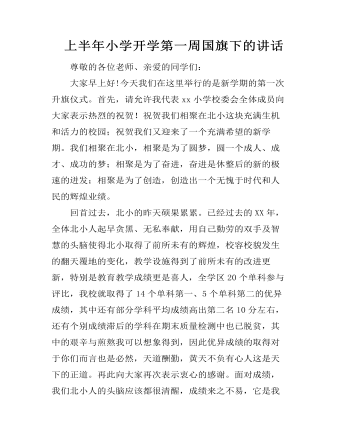
上半年小学开学第一周国旗下的讲话
尊敬的各位老师、亲爱的同学们:大家早上好!今天我们在这里举行的是新学期的第一次升旗仪式。首先,请允许我代表xx小学校委会全体成员向大家表示热烈的祝贺!祝贺我们相聚在北小这块充满生机和活力的校园;祝贺我们又迎来了一个充满希望的新学期。我们相聚在北小,相聚是为了圆梦,圆一个成人、成才、成功的梦;相聚是为了奋进,奋进是休整后的新的极速的迸发;相聚是为了创造,创造出一个无愧于时代和人民的辉煌业绩。回首过去,北小的昨天硕果累累。已经过去的XX年,全体北小人起早贪黑、无私奉献,用自己勤劳的双手及智慧的头脑使得北小取得了前所未有的辉煌,校容校貌发生的翻天覆地的变化,教学设施得到了前所未有的改进更新,特别是教育教学成绩更是喜人,全学区20个单科参与评比,我校就取得了14个单科第一、5个单科第二的优异成绩,其中还有部分学科平均成绩高出第二名10分左右,还有个别成绩滞后的学科在期末质量检测中也已脱贫,其中的艰辛与煎熬我可以想象得到,因此优异成绩的取得对于你们而言也是必然,天道酬勤,黄天不负有心人这是天下的正道。再此向大家再次表示衷心的感谢。面对成绩,我们北小人的头脑应该都很清醒,成绩来之不易,它是我们师生不知用多少汗水及奋力拼搏才换来,因此,今天我们在此的每一个人都应该倍加珍惜这来之不易的荣誉,并用行动去捍卫和巩固这份荣誉。
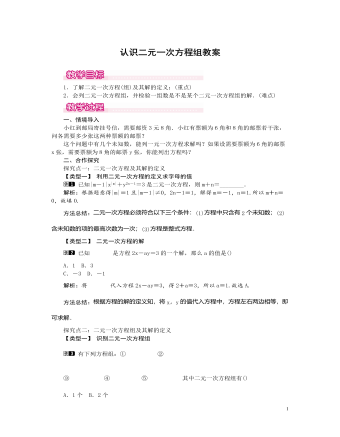
北师大初中数学八年级上册认识二元一次方程组1教案
小刘同学用10元钱购买两种不同的贺卡共8张,单价分别是1元与2元.设1元的贺卡为x张,2元的贺卡为y张,那么x,y所适合的一个方程组是()A.x+y2=10,x+y=8 B.x2+y10=8,x+2y=10C.x+y=10,x+2y=8 D.x+y=8,x+2y=10解析:根据题意可得到两个相等关系:(1)1元贺卡张数+2元贺卡张数=8(张);(2)1元贺卡钱数+2元贺卡钱数=10(元).设1元的贺卡为x张,2元的贺卡为y张,可列方程组为x+y=8,x+2y=10.故选D.方法总结:要判断哪个方程组符合题意,可从题目中找出两个相等关系,然后代入未知数,即可得到方程组,进而得到正确答案.三、板书设计二元一次方程组二元一次方程及其解的定义二元一次方程组及其解的定义列二元一次方程组通过自主探究和合作交流,建立二元一次方程的数学模型,学会逐步掌握基本的数学知识和方法,形成良好的数学思维习惯和应用意识,提高解决问题的能力,感受数学创造的乐趣,增进学好数学的信心,增加对数学较全面的体验和理解.
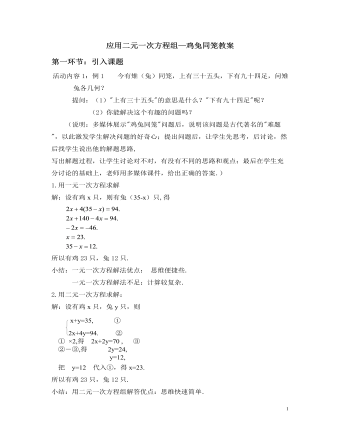
北师大初中数学八年级上册应用二元一次方程组——鸡兔同笼2教案
第三环节:课堂小结活动内容:1. 通过前面几个题,你对列方程组解决实际问题的方法和步骤掌握的怎样?2. 这里面应该注意的是什么?关键是什么?3. 通过今天的学习,你能不能解决求两个量的问题?(可以用二元一次方程组解决的。4. 列二元一次方程组解决实际问题的主要步骤是什么?说明:通过以上四个问题,学生基本上掌握了列二元一次方程组解决实际问题的方法和步骤,可启发学生说出自己的心得体会及疑问.活动意图:引导学生自己小结本节课的知识要点及数学方法,使知识系统化.说明:还可以建议有条件的学生去读一读《孙子算经》,可以在网上查,找出自己喜欢的问题,互相出题;同位的同学还可互相编题考察对方;还可以设置"我为老师出难题"活动,每人编一道题,给老师,老师再提出:"谁来帮我解难题",以此激发学生的学习兴趣和信心。

北师大初中数学八年级上册应用二元一次方程组——鸡兔同笼1教案
解:设甲班的人数为x人,乙班的人数为y人,根据题意,得x+y=93,14x+13y=27,解得x=48,y=45.答:甲班的人数为48人,乙班的人数为45人.方法总结:设未知数时,一般是求什么,设什么,并且所列方程的个数与未知数的个数相等.解这类问题的应用题,要抓住题中反映数量关系的关键字:和、差、倍、几分之几、比、大、小、多、少、增加、减少等,明确各种反映数量关系的关键字的含义.三、板书设计列方程组,解决问题)一般步骤:审、设、列、解、验、答关键:找等量关系通过“鸡兔同笼”,把同学们带入古代的数学问题情景,学生体会到数学中的“趣”;进一步强调数学与生活的联系,突出显示数学教学的实际价值,培养学生的人文精神;进一步丰富学生数学学习的成功体验,激发学生对数学学习的好奇心,进一步形成积极参与数学活动、主动与他人合作交流的意识.
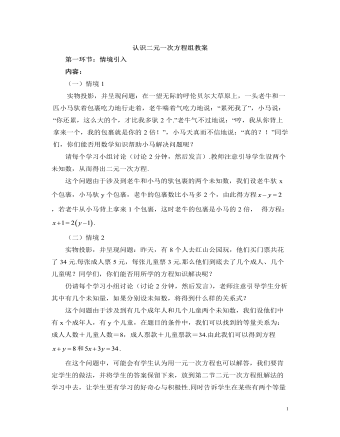
北师大初中数学八年级上册认识二元一次方程组2教案
第一环节:情境引入内容:(一) 情境1实物投影,并呈现问题:在一望无际的呼伦贝尔大草原上,一头老牛和一匹小马驮着包裹吃力地行走着,老牛喘着气吃力地说:“累死我了”,小马说:“你还累,这么大的个,才比我多驮2个.”老牛气不过地说:“哼,我从你背上拿来一个,我的包裹就是你的2倍!”,小马天真而不信地说:“真的?!”同学们,你们能否用数学知识帮助小马解决问题呢?请每个学习小组讨论(讨论2分钟,然后发言).教师注意引导学生设两个未知数,从而得出二元一次方程.这个问题由于涉及到老牛和小马的驮包裹的两个未知数,我们设老牛驮x个包裹,小马驮y个包裹,老牛的包裹数比小马多2个,由此得方程 ,若老牛从小马背上拿来1个包裹,这时老牛的包裹是小马的2倍, 得方程: .
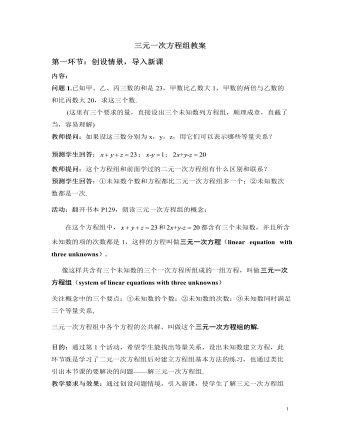
北师大初中数学八年级上册三元一次方程组2教案
目的:课后作业设计包括了两个层面:作业1是为了巩固基础知识而设计;作业2是为了扩展学生的知识面;拓广知识,增加学生对数学问题本质的思考而设计,通过此题可让学生进一步运用三元一次方程组解决问题.教学设计反思1.本节课的内容属于选修学习的内容,主要突出对数学兴趣浓厚、学有余力的同学进一步探究和拓展使用,在数学方法和思想方面需重点引导,通过引导,使学生明白解多元方程组的一般方法和思想,理解巩固环节需多注意多种解题方法的引导,并且比较各种解题方法之间的优劣,总结出解多元方程的基本方法.2.作为选修课,在内容上要让学生理解三元一次方程组概念的同时,要让学生理解为什么要用三元一次方程组甚至多元方程组去求解实际问题的必要性,从而掌握本堂课的基础知识.在教学的过程中,要让学生充分理解对复杂的实际问题方程中元越多,等量关系的建立就越直接;充分理解代入消元法和加减法解方程的优点和缺点,有关这一方面的题目要让学生充分讨论、交流、合作,其理解才会深刻.
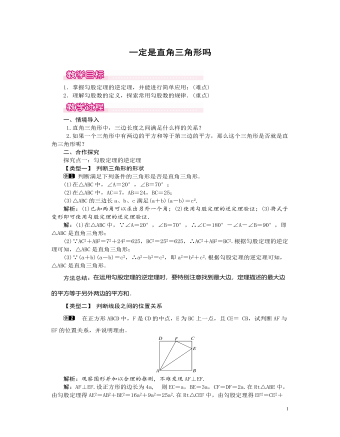
北师大初中数学八年级上册一定是直角三角形吗1教案
方法总结:利用三角形三边的数量关系来判定直角三角形,从而推出两线的垂直关系.探究点二:勾股数下列几组数中是勾股数的是________(填序号).①32,42,52;②9,40,41;③13,14,15;④0.9,1.2,1.5.解析:第①组不符合勾股数的定义,不是勾股数;第③④组不是正整数,不是勾股数;只有第②组的9,40,41是勾股数.故填②.方法总结:判断勾股数的方法:必须满足两个条件:一要符合等式a2+b2=c2;二要都是正整数.三、板书设计勾股定理的逆定理: 如果一个三角形的三边长a,b,c满足a2+b2=c2,那么这个三角形是直角三角形.勾股数:满足a2+b2=c2的三个正整数,称为勾股数.经历一般规律的探索过程,发展学生的抽象思维能力、归纳能力.体验生活中数学的应用价值,感受数学与人类生活的密切联系,激发学生学数学、用数学的兴趣.
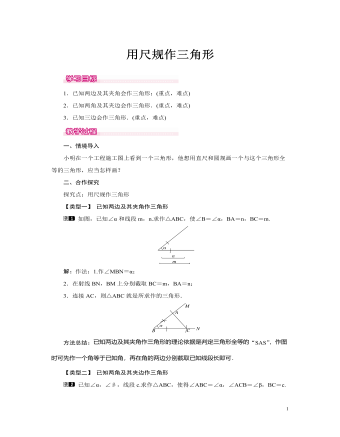
北师大初中七年级数学下册用尺规作三角形教案
【类型三】 已知三边作三角形已知三条线段a、b、c,用尺规作出△ABC,使BC=a,AC=b、AB=c.解:作法:1.作线段BC=a;2.以点C为圆心,以b为半径画弧,再以B为圆心,以c为半径画弧,两弧相交于点A;3.连接AC和AB,则△ABC即为所求作的三角形,如图所示.方法总结:已知三角形三边的长,根据全等三角形的判定“SSS”,知三角形的形状和大小也就确定了.作三角形相当于确定三角形三个顶点的位置.因此可先确定三角形的一条边(即两个顶点),再分别以这条边的两个端点为圆心,以已知线段长为半径画弧,两弧的交点即为另一个顶点.三、板书设计1.已知两边及其夹角作三角形2.已知两角及其夹边作三角形3.已知三边作三角形本节课学习了有关三角形的作图,主要包括两种基本作图:作一条线段等于已知线段,作一个角等于已知角.作图时,鼓励学生一边作图,一边用几何语言叙述作法,培养学生的动手能力、语言表达能力
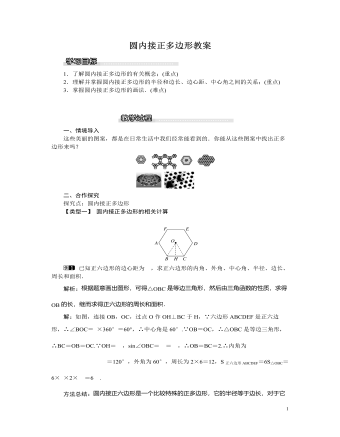
北师大初中九年级数学下册圆内接正多边形教案
解析:正多边形的边心距、半径、边长的一半正好构成直角三角形,根据勾股定理就可以求解.解:(1)设正三角形ABC的中心为O,BC切⊙O于点D,连接OB、OD,则OD⊥BC,BD=DC=a.则S圆环=π·OB2-π·OD2=πOB2-OD2=π·BD2=πa2;(2)只需测出弦BC(或AC,AB)的长;(3)结果一样,即S圆环=πa2;(4)S圆环=πa2.方法总结:正多边形的计算,一般是过中心作边的垂线,连接半径,把内切圆半径、外接圆半径、边心距,中心角之间的计算转化为解直角三角形.变式训练:见《学练优》本课时练习“课后巩固提升”第4题【类型四】 圆内接正多边形的实际运用如图①,有一个宝塔,它的地基边缘是周长为26m的正五边形ABCDE(如图②),点O为中心(下列各题结果精确到0.1m).(1)求地基的中心到边缘的距离;(2)已知塔的墙体宽为1m,现要在塔的底层中心建一圆形底座的塑像,并且留出最窄处为1.6m的观光通道,问塑像底座的半径最大是多少?
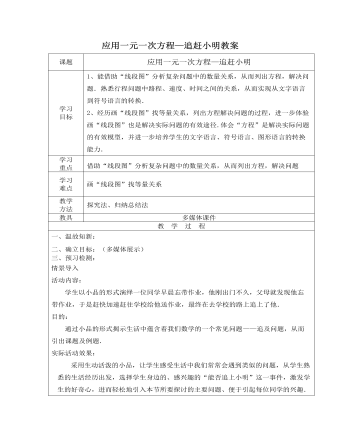
北师大初中七年级数学上册应用一元一次方程——追赶小明教案2
由于题目较简单,所以学生分析解答时很有信心,且正确率也比较高,同时也进一步体会到了借助“线段图”分析行程问题的优越性.六、归纳总结:活动内容:学生归纳总结本节课所学知识:1.会借线段图分析行程问题.2.各种行程问题中的规律及等量关系.同向追及问题:①同时不同地——甲路程+路程差=乙路程; 甲时间=乙时间.②同地不同时——甲时间+时间差=乙时间; 甲路程=乙路程.相向的相遇问题:甲路程+乙路程=总路程; 甲时间=乙时间.目的:强调本课的重点内容是要学会借线段图来分析行程问题,并能掌握各种行程问题中的规律及等量关系.引导学生自己对所学知识和思想方法进行归纳和总结,从而形成自己对数学知识的理解和解决问题的方法策略.

